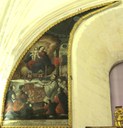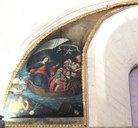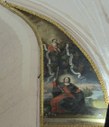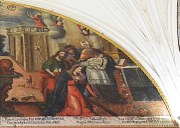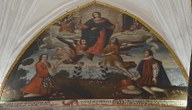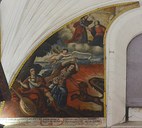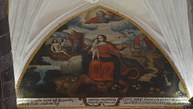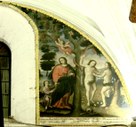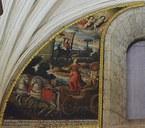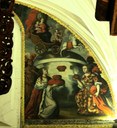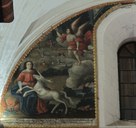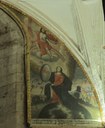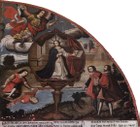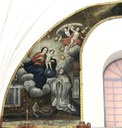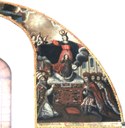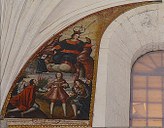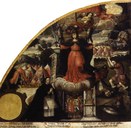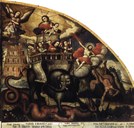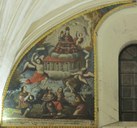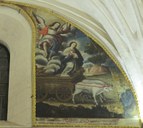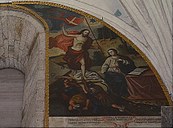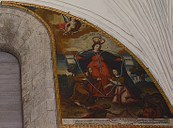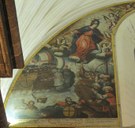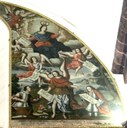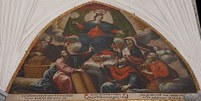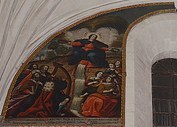Gallery 13:
The Elogia Mariana of the Great Cathedral of Cuzco
Marcos Zapata (ca. 1710-1733) was one of the leading painters of Colonial Cuzco [1]. It was therefore fitting that he contracted to paint no less than fifty canvases for the great Cathedral of Cuzco in 1755 [2]. The canvases had to illustrate the Lauretan Litany. And they had to be executed by Zapata himself, con todo cuidado, prolexidad, y colores finos.
As it turns out, Zapata honored his contract by painting fifty canvases that filled the blind arches crowning the perimetric walls of the main temple of the Cathedral Complex in Cuzco. This was no mean feat. In fact, with its 250 square meters of painting, the Zapata series has come down in history as the largest pictorial effort issuing from Colonial Cuzco [3].
But the volume of the work was not the only challenge Zapata had to face. Some of the blind arches to be adorned were pointed while others were rounded. While the pointed arches were filled by one canvas, the rounded arches were filled by two. Each one of these two paintings covered one quadrant (except that most of the rounded arches also contained windows and, needless to say, the canvases for them had to flank these windows without covering them). Beyond this, there were the rectangular shapes of the two canvases that close the series and hang outside any arches. It follows that the canvases of the series had to come in no less than six different shapes (as well as a variety of sizes).
Unpublished research conducted by Santiago Sebastián in the 1970s led him to claim that Zapata's paintings followed closely fifty of the illustrations to the Elogia Mariana of August Casimir Redel (1656-1705), a work that was published posthumously in Augsburg in 1732 [4]. The illustrations to the Elogia Mariana were invented and drawn by Thomas Scheffler (1699-1756), one of the leading artists of the German Rococo. They were engraved and published by Martin Engelbrecht (1684-1756), one of the most important engravers and printers of the Imperial City of Augsburg.
The Elogia Mariana of Redel consists of fifty nine emblems based on the Lauretan Litany. Being emblems, the illustrations of the Elogia Mariana consist of three distinct parts each: a pictura (or image), a motto (or title), and a subscriptio (or epigrammatic explanation). Not content with this, Redel's Elogia Mariana enriches the tripartite structure of an emblem by the addition of a fourth element. It is the anagramma (or anagram), a clever permutation of the letters of the motto to form a grammatical phrase related to the motto in the subscriptio.
To illustrate, let us take the thirty-third engraving from the Elogia Mariana (PESSCA 752A). Its pictura (or image) represents heaven and earth engaged in joyous music-making. Its motto is CAUSA NOSTRA LAETITIA (Cause of our joy). Its anagramma is SI VIA LACTEA TOTA SERENA (As if all of the Milky Way were serene), which is indeed an anagram of the motto:

As to its subscriptio (or epigrammatic explanation), it is as follows (Say AVE, Marian cultists, for cause of our joy; for cause of our salvation. Let us sing joyous. All of The Milky Way is serene, for this song dissipates the darkness of the Styx).
Dicite cultores mariani dicite CAUSA
NOSTRAE LAETITIAE causa salutis ave
Cantemus laeti VIA LACTEA TOTA SERENA EST
nam stygias tenebras dissipat hocce melos.
But let us return to Sebastian's claim. Although it is unassailable for 46 of the Zapata paintings, questions may be raised for the remaining four. The first of them regards a missing canvas of the Zapata series. It is the Mater Admirabilis. It has been replaced by a 20th century rendition of the original (see PESSCA 2738B). Although it is probable that the original painting followed its Engelbrecht source closely (see PESSCA 742A), we cannot be sure unless and until the original emerges.
Two other questions deal with the paintings found directly over the main altar of the Cathedral (see below). It is arguable that these paintings follow two different portions of an Engelbrecht engraving —Plate 11 of his Elogia Mariana, an emblem whose motto is Sancta Trinitas Unus Deus, Miserere Nobis. The choice would make sense in the sequence, as the paintings in question hang between paintings whose sources are Plates 5 and 12. But these paintings do not follow Plate 11 nearly as closely as the rest —hence the questions.

But the most interesting challenge to Sebastian's claim deals with the painting below.

It is clear that this painting is not based on any of the engravings of the Engelbrecht series. So where does it come from and what does it represent? According to Mesa & Gisbert (1982, I, 212-213), this painting is not part of the original Zapata series, but rather a fragment of a painting by another artist (the original Zapata painting supposedly illustrated the Rosa Mystica invocation, and its current whereabouts are unknown).
Altough these assertions are echoed in more recent studies [5], no support whatsoever is provided for them. So perhaps we may be allowed to propose that this painting is, in fact, an invention of the Zapata Workshop, and that it represents the donors of his paintings. If so, standing at the center of the composition and striking an expository pose might be Diego del Barrio y Mendoza, the learned priest from Potosí who served as Treasurer of the Cabildo of the Cathedral and donated the entire Zapata series [6]. Standing behind him might be other members of the Cabildo, and the couple to his right could be portraits of his wealthy benefactors.
It should be noted that Father del Barrio y Mendoza is depicted, with his coat of arms, in another painting of the series —the Turris Davidica (PESSCA 64B) [7]. And that the individuals portraited in them are rather similar.
Be that as it may, we include in this gallery all the correspondences of this important series of Cuzco paintings. These hitherto unpublished paintings appear in PESSCA for the first time.
Notes
[1] See Mesa & Gisbert 1982, I, 209ss.
[2] See the contract published in Revista del Archivo Histórico del Cuzco II: 291-293. Even though the contract prevented Zapata from subcontracting the job, it has been argued that the two rectangular paintings that close the series are weaker works of collaborators.
[3] See Mesa & Gisbert 1982, I, 210.
[4] See Gisbert & Mesa & Sebastián (1979). For the sources of Redel's work, see Carme López Calderón, "Quién es quién en la Elogia Mariana de A.C. Redelio," available online at academia.edu/7715485.
[5] Schenone, Santa María: Iconografía del Arte Colonial, p. 578; Tesoros de la Catedral del Cusco, p. 286.
[6] That he was the donor for the series is asserted in Mesa & Gisbert (1982, I, 210), Sebastián (1985, 215), and Sebastián (1990, 164).
[7] Tesoros de la Catedral del Cusco, loc. cit.


